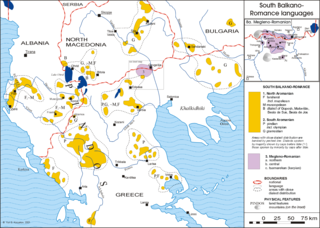It has been requested that the title of this article be changed to Balkan Romance substratum . Please see the relevant discussion. The page should not be moved unless the discussion is closed; summarizing the consensus achieved in support of the move. |
This article includes a list of references, related reading or external links, but its sources remain unclear because it lacks inline citations .(February 2008) (Learn how and when to remove this template message) |
According to the official theory regarding the origin of the Eastern Romance languages, they developed from the local Vulgar Latin spoken in the region of the Balkans. That there is a connection between the Vulgar Latin and the Paleo-Balkan languages spoken in the area is a certainty. Taking into consideration the geographical area where this languages are spoken and the fact that there is not much information about the Paleo-Balkan languages, it is considered that the substratal of the Eastern Romance languages should be the ancient Thracian and Dacian.
The Eastern Romance languages are a group of Romance languages. Today, the group consists of the Balkan Romance subgroup which comprises the Romanian language (Daco-Romanian), Aromanian language (Macedo-Romanian) and two other related minor languages, Megleno-Romanian and Istro-Romanian; and the Castelmezzano dialect, in southern Italy.

Vulgar Latin or Sermo Vulgaris, also Colloquial Latin, or Common Romance, was a range of non-standard sociolects of Latin spoken in the Mediterranean region during and after the classical period of the Roman Empire. It is distinct from Classical Latin, the standard and literary version of the language. Compared to Classical Latin, written documentation of Vulgar Latin appears less standardized. Works written in Latin during classical times and the earlier Middle Ages used prescribed Classical Latin rather than Vulgar Latin, with very few exceptions, thus Vulgar Latin had no official orthography of its own.

The BalkansBAWL-kənz, also known as the Balkan Peninsula, is a geographic area in southeastern Europe with various definitions and meanings, including geopolitical and historical. The region takes its name from the Balkan Mountains that stretch throughout the whole of Bulgaria from the Serbian-Bulgarian border to the Black Sea coast. The Balkan Peninsula is bordered by the Adriatic Sea on the northwest, the Ionian Sea on the southwest, the Aegean Sea in the south and southeast, and the Black Sea on the east and northeast. The northern border of the peninsula is variously defined. The highest point of the Balkans is Mount Musala, 2,925 metres (9,596 ft), in the Rila mountain range, Bulgaria.
Contents
The substratal elements in the languages are mostly lexical items. Around 300 words are considered by many linguists to be of substratum origin. Including place-names and river-names, and most of the forms labelled as being of unknown etymology, the number of the substratum elements in Eastern Romance may surpass 500 basic roots. Linguistic research in recent years has increased the body of Eastern Romance words that may be considered indigenous.
A lexicon, word-hoard, wordbook, or word-stock is the vocabulary of a person, language, or branch of knowledge. In linguistics, a lexicon is a language's inventory of lexemes. The word "lexicon" derives from the Greek λεξικόν (lexicon), neuter of λεξικός (lexikos) meaning "of or for words."

Etymology is the study of the history of words. By extension, the phrase "the etymology of [some word]" means the origin of the particular word. For place names, there is a specific term, toponymy.
In addition to vocabulary items, some other features of Eastern Romance, such as phonological features and elements of grammar (see Balkan sprachbund) may also be from Paleo-Balkan languages.
A vocabulary is a set of familiar words within a person's language. A vocabulary, usually developed with age, serves as a useful and fundamental tool for communication and acquiring knowledge. Acquiring an extensive vocabulary is one of the largest challenges in learning a second language.
In the phonology of the Romanian language, the phoneme inventory consists of seven vowels, two or four semivowels, and twenty consonants. In addition, as with all languages, other phonemes can occur occasionally in interjections or recent borrowings.
The Balkan Sprachbund or Balkan language area is the ensemble of areal features—similarities in grammar, syntax, vocabulary and phonology—among the languages of the Balkans. Several features are found across these languages though not all apply to every single language. The languages in question may belong to various separate branches of Indo-European or even outside of Indo-European. Some of the languages use these features for their standard language whilst other populations to whom the land is not a cultural pivot may still adopt the features for their local register.







